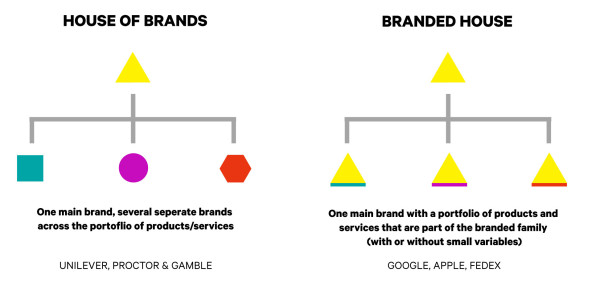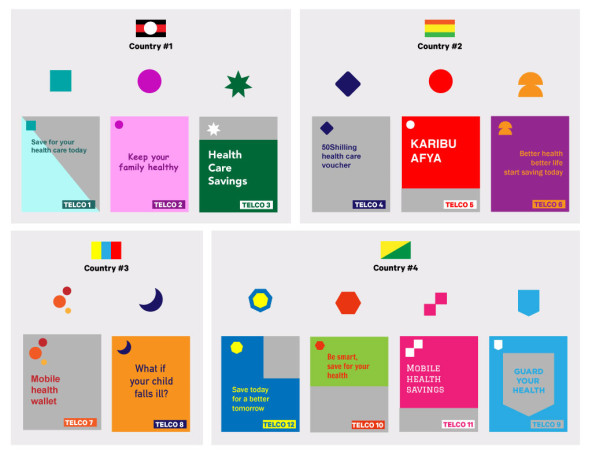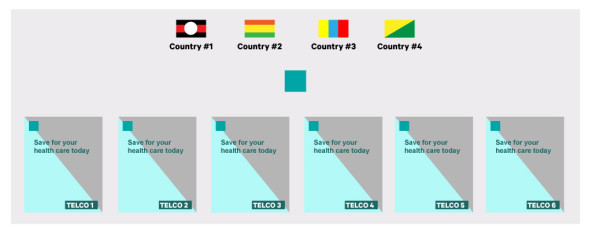Last summer a social enterprise that had successfully launched a savings product for health care on mobile phones in an East African country came to our branding agency with a problem. It had managed to win people’s trust in its ability to keep their money safe. But the secret to building that trust was quickly becoming the company’s biggest challenge—one that could end up costing them millions of dollars over the long term.
As a startup without any reputation, the client had sought and secured a partnership with the largest telecom provider in the country. The partnership provided the social enterprise with the phone network it needed, as well as a trusted name to include on all its communication materials. It also allowed the enterprise to borrow visual clues from the telecom’s logo and color scheme for its own brand. The visual kinship between the companies lent credibility to the new enterprise, and within a year, thousands of people signed up and were saving money through its service.
Then came the challenge. The mission of the social enterprise was to empower all people—not just the subscribers of one particular telecom company—to save for health care. But to reach people who subscribed to other telecom providers, it would need more telecom partnerships. How would that work when its brand was explicitly linked to their competition?
The client faced two options: create different brands for each new telecom partnership or rework its original brand to accommodate multiple providers.
Are you enjoying this article? Read more like this, plus SSIR's full archive of content, when you subscribe.
As brand developers, we face this type of dilemma all the time. The way organizations structure their brands, and how these brands relate to or differ from each other, is called brand architecture, and it is one of the highest-level strategic decisions organizations can make. The temptation to create a new brand is always there, and it is easy to fall for it. A new brand can be an effective communication vessel if you are moving into a new market, if a new type of audience doesn’t relate to your current brand, or if your mission, values, or price-positioning are at odds with your current brand.
 Two examples of how companies can structure products or services within their portfolio.
Two examples of how companies can structure products or services within their portfolio.
However, social ventures and nonprofits often make the mistake of creating too many brands, sub-brands, or labels for their organizations, products, or services. In doing so, they end up spreading themselves too thin, and as a result, their communication efforts have less impact.
So how to decide which way to go?
A visualization exercise we use with clients can help make the decisions and consequences of each choice clear. For our health care savings enterprise, we mapped out the two scenarios (create a new brand for each telecom provider or rework the existing brand), and then illustrated the consequences of each by creating mock logos and brochure covers. These mockups gave the client and its leadership team a clear picture of what they would embark on. (Note: The mockups shared below were created specifically to enable public sharing of the case study, without disclosing the identity of the client and their telecom provider partner.)
Scenario A: Keep the current brand and create a new one for each new telecom partner.
 Here, the health care savings product is presented to customers of the different telecom providers as separate brands. The three brands would have different names, and each would have a strong visual link to the telecom provider.
Here, the health care savings product is presented to customers of the different telecom providers as separate brands. The three brands would have different names, and each would have a strong visual link to the telecom provider.
This scenario seems reasonably doable until you consider the client’s ambition to scale the product across the continent. If the enterprise continued to follow the strategy of aligning its brand with telecom providers for each launch, it would be managing dozens of brands. And while this would avoid the cost of rebranding and loss of brand recognition incurred if the organization rebranded its first brand, it adds infinitely more costs in the long term. Imagine trademarking dozens of brand names, creating dozens of visual identities and campaigns, and claiming and managing all those social media channels. Not to mention the fact that the brands would compete with each other.
 If the social enterprise follows its initial strategy of creating brands aligned with telecom partners, it would quickly grow out of control if it is successful and expands into different countries with dozens more telecom providers.
If the social enterprise follows its initial strategy of creating brands aligned with telecom partners, it would quickly grow out of control if it is successful and expands into different countries with dozens more telecom providers.
When would it make sense to create multiple brands? If the health care savings venture wanted to expand from its base-of-the-pyramid clientele to wealthier groups, it would have two very different value propositions and would therefore need to differentiate its messaging and look and feel. Or it might need to create a new brand in a different country where its name is not available for trademarking or has bad associations, or a very well-known brand already uses the same brand colors. Or the social venture might decide to sell consumer needs and behavior data to third parties (such as health care providers of pharmaceutical companies) to create a more demand-driven health care system, and therefore choose to have a consumer-facing brand and a more-corporate brand for business partnerships.
Scenario B: Create one brand for all telecom companies and all markets.
 The second scenario shows what happens when the social enterprise creates one brand for all its telecom partnerships: one name and one visual identity across all countries.
The second scenario shows what happens when the social enterprise creates one brand for all its telecom partnerships: one name and one visual identity across all countries.
This scenario would require a rebrand that creates a short-term cost and loss of brand recognition, but long-term savings.
In the case of the health care savings enterprise, the best route to take was clear. The second scenario would require that the enterprise investigate trademarking the name and logo in all potential markets to ensure that it is available and that it has a positive, relevant connotation. But while it would lead to a short-term loss of recognition, it would pay off in the long term. The enterprise could also mitigate the initial loss of brand recognition by changing the brand in stages over time instead of all at once. For instance, it could start by keeping the logo intact, but creating its own distinct photography style and tone of voice. It could change the balance of the main colors of the main telecom provider (for example, changing from mostly green with red accents to mostly red with green accents). By slowly evolving the brand away from its initial connection, it could achieve the second scenario without a dramatic loss of built-up brand recognition.
Partnering with an established organization can provide startups with an incredible boost, but it is important to consider the consequences of marrying brands. Visualization—of both the present and future—can make the decision process much more tangible. A brand takes years to build, so organizations should make sure to anticipate factors that will come into play as it evolves and realizes its ambitions.
In the end, very few startups and even established companies can afford to spread their budget, manpower, and attention across two or more brands. Consider: For every brand you manage, you will need to allocate legal fees, name creation fees, trademarking, domain registration, a visual and verbal identity, messaging, content creation, PR, advertisements, ongoing channel management, a social media following, and more.
The health care social enterprise example makes this clear. If it had chosen to create a new brand for each telecom provider, it would have lost millions of dollars in agency fees, legal fees, and team hours that could have been spent on more important things: getting more people to save for health care.
Support SSIR’s coverage of cross-sector solutions to global challenges.
Help us further the reach of innovative ideas. Donate today.
Read more stories by Anne Miltenburg.

